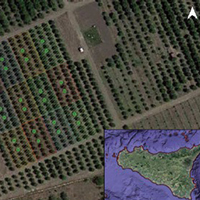Long-term monitoring of deficit irrigation regimes on citrus orchards in Sicily

HTML: 41
All claims expressed in this article are solely those of the authors and do not necessarily represent those of their affiliated organizations, or those of the publisher, the editors and the reviewers. Any product that may be evaluated in this article or claim that may be made by its manufacturer is not guaranteed or endorsed by the publisher.
Authors
The study aims to identify the responses of citrus orchards (C. sinensis (L.) Osbeck), grown under typical Mediterranean climatic conditions, to deficit irrigation (DI) regimes applied over more than a decade (2010-2020). In particular, the DI regimes were declined at the study site in terms of sustained deficit irrigation, regulated deficit irrigation, partial drying of the root-zone, with increasing severity of the water deficit, from 25% to 50% of the crop evapotranspiration, using surface and sub-surface micro-irrigation techniques. Long-term monitoring was set up for identifying the main processes acting at the soil-plant-atmosphere continuum (SPAC) level through direct in situ measurements of mass and energy fluxes (i.e., via micrometeorological technique) and the estimation of ETc and transpiration fluxes (i.e., via sap flow method), and the soil-plant-water processes (via geoelectrical techniques). In addition, the main physiological, qualitative, and quantitative parameters were evaluated since the beginning of the experiment. The results of the long-term experiment demonstrated the great adaptability of the crop species to sustain even the highest water reductions without substantial alterations of the main marketable productive and qualitative characteristics, evidencing the importance of controlling the SPAC dynamics for correctly applying the water restriction regimes.
How to Cite

This work is licensed under a Creative Commons Attribution-NonCommercial 4.0 International License.
PAGEPress has chosen to apply the Creative Commons Attribution NonCommercial 4.0 International License (CC BY-NC 4.0) to all manuscripts to be published.

 https://doi.org/10.4081/jae.2021.1193
https://doi.org/10.4081/jae.2021.1193



